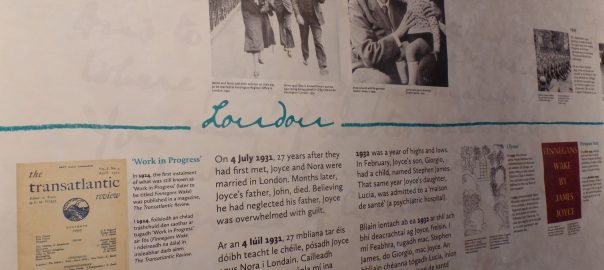Irish writers were hot in in the 1960s and 70s. My university friends and I read Joyce, Yeats, and Beckett. My Fair Lady, based on the George Bernard Shaw play Pygmalion, was a hit musical movie. Oscar Wilde was and still is remembered as a larger-than-life character even though he died in 1900. I encountered these authors and more during my visit to Ireland in June.
On our first day in Dublin, my husband Will and I wandered by the colourful statue of Oscar Wilde in Merrion Square.

Monuments near the rock depict Wilde’s numerous witticisms. “Always forgive your enemies: nothing annoys them so much.”
A few blocks away, in St. Stephen’s Green, we met James Joyce.

Jonathan Swift, author of the satire Gulliver’s Travels, was our third Dublin writer that day. Swift served as Dean of St. Patrick’s Cathedral and was known for his controversial opinions. He’s buried in the cathedral along with a woman, Esther Johnson, with whom he shared a mysterious relationship.
Swift in St. Patrick’s Cathedral
The next day, we boarded our tour bus and drove around the island. Our guide mentioned several times that Ireland has four Nobel Prize Winners for Literature, a lot for a small country. They are William Butler Yeats, George Bernard Shaw, Seamus Heaney, and Samuel Beckett, “who wrote the most boring play ever written,” she said about Waiting for Godot. We met Yeats in his home County Sligo on the northwest coast.

I find Yeats’ 1919 poem, The Second Coming, written during the aftermath of WWI, sadly relevant today. “The best lack all conviction, while the worst Are full of passionate intensity.”
At the end of our trip, we returned to Dublin. Will and I went to MoLI (Museum of Literature Ireland), housed in the city’s former Catholic College, which James Joyce attended. Inside there’s a photo of Joyce and his fellow students sitting under this tree that still stands in the back garden.

The museum includes past and present Irish writers, but the focus is James Joyce. A movie and wall panels portray the author’s life.

A 3-d map of Dublin marks locations in Joyce’s short stories and novels.

The first draft of Joyce’s most famous novel, Ulysses, is displayed, showing the author’s colour coding method.

And here’s the first copy of the first edition of Ulysses.

In my youth, I enjoyed Joyce’s first two books, but didn’t tackle Ulysses because everyone said it was inaccessible. After my trip, I skimmed the first fifty pages and can boast that I sometimes understood what was going on. I see on the MoLI website they offer an online book club this summer called Ulysses – for the rest of us! The fortnightly sessions promise to demystify the novel. I’m not quite up to the challenge this summer, but maybe next year.
